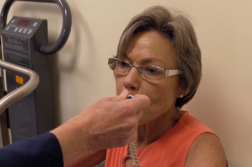ORLANDO, Fla. (Ivanhoe Newswire) — It started with the Fitbit, and now other wearable devices are being used to track a person’s health. They’re small, portable, and convenient. So, what are the latest high-tech gadgets on the market? There are four new devices that could change the way doctors treat patients.
The future of healthcare could be something you wear!
“Every day you have more applications, wearable devices that are out there in the market,” said Khaldoun Tarakji, MD, an Electrophysiologist at the Cleveland Clinic.
One of those is the Ava bracelet. It’s an FDA approved device that monitors a woman’s fertility and menstrual cycle by collecting up to three million data points that are linked to a rise in reproductive hormones. Women simply put the watch on before bed, and it syncs with a mobile app. And, the fever scout is a wearable patch that’s placed near a person’s armpit. It tracks their temperature over time, and smartphone alerts let caregivers know if there’s a fever spike.
Another device could take the pain out of blood sugar testing for people with diabetes. The K’track Glucose Monitor uses microneedles that are less than 0.5 millimeters to collect and analyze fluid right below the skin surface. The Live by Earlysense is a remote sensor that monitors sleep and vital stats for patients who can’t get out of bed. Clinical studies have shown it’s about 93 percent accurate at detecting sleep patterns, heart rate, breathing, movement, and other data.
The number of wearable devices shipped to consumers is expected to reach 130 million by 2018.
Contributors to this news report include: Julie Marks, Producer; Roque Correa, Editor.
Free weekly e-mail on Medical Breakthroughs from Ivanhoe. To sign up: http://www.ivanhoe.com/ftk
4 SMART DEVICES FOR YOUR HEALTH
REPORT #2446
BACKGROUND: Physical health is measured by regular physical activity, good nutrition, and adequate rest. Physical health has been the basis for active living campaigns and the many nutrition drives that have swept the industrialized world. Being physically fit refers to a person’s cardiorespiratory endurance, muscular strength, flexibility, and body composition. Other contributors to physical fitness may include bodyweight management, abstaining from drug abuse, avoiding alcohol abuse, and hygiene. Physical health can be divided into two groups: structural health which refers to sound bones, muscles and organs and chemical health where tissues contain the right balance of nutrients and no toxins. People’s good or bad health can also be determined by their environment and situations. Some experts believe these factors have a bigger impact on our health than access and use of healthcare services: where we live, the state of our environment, genetics, our income, our education level, and our relationship with friends and family. People are exposed to so much “physical health” data these days that it is hard to decide what is relevant and what is not.
(Source: http://www.medicalnewstoday.com/articles/150999.php)
THE FACTS: Technology has made monitoring our health and fitness easier, cheaper and more convenient than ever, with an array of apps and wearable devices starting from fitness trackers and smartwatches to headphones and clothing. These are all designed to improve our well-being. Smartwatches may be cool; however, wearable health monitoring devices could save your life. These devices can help manage chronic disease and even optimize fitness programs. Wearable devices provide output and connect to the Web in various ways. Some allow wearers to monitor their own readings using a mobile phone and a special website. Others allow data to be downloaded and viewed by third parties such as healthcare managers or doctors who are watching for unusual trends where medical intervention may be needed. Some devices simply encourage wearers to share their fitness progress with work-out buddies and friends through social media sites.
(Source: http://newatlas.com/top-personal-health-fitness-technology-2014/35158/; https://www.informationweek.com/mobile/10-wearable-devices-to-keep-patients-healthy/d/d-id/1104359?page_number=1)
INTO THE FUTURE: Wearable technology jumped 29% in 2016 with 101.9 million units sold. Research projects that number will reach more than 213 billion by 2020. The most popular devices continue to be wristbands and watch-like devices, though clothing and eyewear are gaining traction. Wearable technology is evolving as technology companies partner with healthcare organizations with the goal of solving some of healthcare’s biggest problems. A few on the market now: wearable patch that monitors temperature, smart board with hand grip to assist patients with shoulder and elbow mobility, Bluetooth sensor glove to assist stroke victims, and a device that monitors sleep patterns. Other technology being released later this year: a watch glucose monitor for diabetes patients and a computerized shoe to track runner’s vitals. A study found health organizations (doctors, hospitals, health insurance companies) are the most trusted when referring wearables to their customers.
* For More Information, Contact:
Andrea Pacetta
Public Relations



